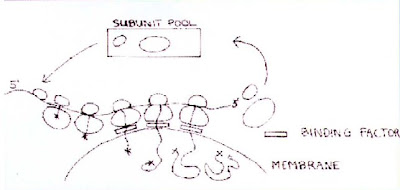 The Signal Hypothesis describes the mechanism whereby proteins that are destined to cross a membrane are synthesized. One of the key components of this pathway is Signal Recognition Particle or SRP. The structure of SRP is shown below from a paper by Maity and Weeks (2007)
The Signal Hypothesis describes the mechanism whereby proteins that are destined to cross a membrane are synthesized. One of the key components of this pathway is Signal Recognition Particle or SRP. The structure of SRP is shown below from a paper by Maity and Weeks (2007)Most of SRP is composed of an RNA molecule called 7SL RNA. It is shown as red and yellow helices in the bottom figure. The secondary structure is depicted in the top right-hand corner of the figure. There are six different proteins in SRP. All of them are bound to the RNA in one way or another. The six proteins are SRP9, SRP14, SRP54, SRP68, and SRP72. The numbers refer to the molecular mass in kilodaltons.

 There are three genes for 7SL RNA. They are all found on chromosome 14 (above). Two of them are closely linked and the third one is somewhat farther away.
There are three genes for 7SL RNA. They are all found on chromosome 14 (above). Two of them are closely linked and the third one is somewhat farther away. - RN7SL1: Entrez Gene 6029. Chromosome 14q22.1
- RN7SL2: Entrez Gene 378706. Chromosome 14
- RN7SL3: Entrez Gene 378707. Chromosome 14
The genes for the protein components are:
- SRP9: Entrez Gene 6726. Chromosome 1q42.12
- SRP14: Entreez Gene 6727. Chromosome 15q22
- SRP54: Entrez Gene 6729. Chromosome 14q13.2
- SRP68: Entrez Gene 6730. Chromosome 17q25.1
- SRP72: Entrez Gene 6731. Chromosome 4q11

 The three membrane components are the SRP receptor, the translocon (formerly known as ribophorin), and the signal peptidase. There are two subunits in the SRP receptor, α (docking protein) and β. The human genome contains a single gene for SRP receptor α subunit called SSPR (SSPRα). The genome has two separate genes for the β subunit called SSRB and SSR2.
The three membrane components are the SRP receptor, the translocon (formerly known as ribophorin), and the signal peptidase. There are two subunits in the SRP receptor, α (docking protein) and β. The human genome contains a single gene for SRP receptor α subunit called SSPR (SSPRα). The genome has two separate genes for the β subunit called SSRB and SSR2.- SSPR (Docking protein) (SSRα): Entrez Gene 6734. Chromosome 11q24.3
- SRPRB: Entrez Gene 58447. Chromosome 3q22.1
- SSR2: Entrez Gene 6746. Chromosome 1q21-q23
The translocon is composed of three proteins; SEC61, SEC62, and SEC63. The SEC61 protein has three subunits; α (genes SEC61A1 and SEC61A2), β (gene SEC61B), and γ (gene SEC61G).
- SEC61A1: Entrez Gene 29927. Chromosome 3q21.3
- SEC61A2: Entrez Gene 55176. Chromosome 10p14
- SEC61B: Entrez Gene 10952. Chromosome 9q22.32-q31.3
- SEC61G: Entrez Gene 23480. Chromosome 7p11.2
- TLOC1 (SEC62): Entrez Gene 7095. Chromosome 3q26.2
- SEC63: Entrez Gene 11231. Chromosome 6q21
Finally, there are three subunits of the signal peptidase complex encoded by SPCS1 (signal peptidase complex, subunit 1), SPCS2, and SPCS3.
- SPCS1: Entrez Gene 28972. Chromosome 3q22.1
- SPCS2: Entrez Gene 9789. Chromosome 1q21-q23
- SPCS3: Entrez Gene 60559. Chromosome 11q24.3
There are 20 genes required for effective translocation of proteins with a signal sequence (only the SRP are shown on the chromosome maps). Additional proteins are required to assist in the translocation (chaperones) and in glycosylation of the protein once it enters the lumen of the endoplasmic reticulum.
Maity, T.S. and Weeks, K.M. (2007) A threefold RNA-protein interface in the signal recognition particle gates native complex assembly. J. Mol. Biol. 369:512-24 [PubMed]







































